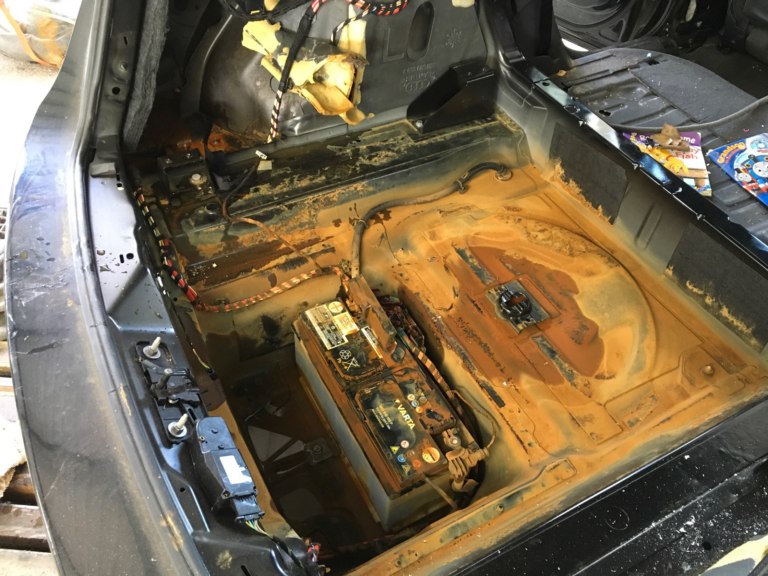Corrosion
Quick answer: Corrosion is the chemical attack on metal – usually rust on steel – caused by moisture, salt and oxygen. In cars it eats away at panels, seams and box sections from the inside out, especially where leaks or standing water have been left untreated.
Damp inside of cars will often lead to corrosion of exposed metal parts. Because the interior of the car was never supposed to get wet, many interior parts have minimal weatherproof coatings or none at all.

Moisture will condensate on any hard, cold surface, and so the affected area need not be submerged in water for it to begin to corrode. It is common for us to find brackets up, under the dashboard, to show signs of surface corrosion.
Electrical connectors may be the first items to be effected, but we will cover electrical problems in a separate entry.
The most immediate threat caused by corrosion is to safety equipment. Your seat runners, the bolts that hold your seats to the floor, and the holes they bolt into are very prone to corrosion, as are many of the components of the seat belt tensioner and the points it is bolted to the car. Rust can drastically weaken the high strength components, which could lead to catastrophic results in the event of a collision.
If standing water under your carpets is allowed to sit, it can become contaminated with rust, turning into a corrosive rusty soup. It can quickly eat through interior paintwork and begin corroding the car's bodywork.
Many components are hidden under your car's carpets, from speakers to electrical control units. Aside from these units being prone to expensive damage from water, they are bolted or screwed to the floor, which provides a point of attack for corrosion.
What it means
Corrosion is what happens when metal slowly breaks down. On cars we mainly mean rust on steel – the reddish-brown oxidation you see where paint has failed or water has been sitting. It starts on the surface but, given time and enough moisture and oxygen, it eats deeper into the metal. In leak work, corrosion is often found on floorpans, seat mounts, seams, sills, cross members and inside box sections that have been wet for long periods.
Why it matters
- Weakens structure: Rust reduces the thickness and strength of metal, which can affect sills, chassis rails, cross members and seat belt anchorages that are critical for safety.
- Costs more to fix later: Light surface rust may be treatable, but once corrosion has holed panels or eaten into box sections, repairs become more involved and expensive.
- Linked to leaks and damp: Wherever water is allowed to sit – in footwells, spare wheel wells, sills and box sections – corrosion follows. Stopping the leak and drying the car is as important as treating the rust itself.
- Affects MOT and value: Significant corrosion in prescribed areas will fail an MOT. Even cosmetic rust around arches and seams can put buyers off and reduce a car’s resale value.
Where you will see it
You will see corrosion mentioned in leak reports, water damage assessments, MOT advisories and rust inspections. Typical comments include corrosion present on floorpan under driver’s seat, box section in sill corroded from inside, corrosion around rear vent aperture or surface corrosion only, clean and protect. On leak-damaged cars it is often noted where water has been standing unnoticed in cross members, sills, under carpets or in spare wheel wells.
Context
Corrosion sits at the end of the chain that begins with water ingress. A leak from doors, rear vents, drainage pipes, scuttle or sunroof cassette lets water into places it should not be. If this is not found and dried, moisture lingers in carpets, underlay, soundproofing and box sections. Over time that damp environment allows corrosion to get a foothold on bare or thinly coated metal. A proper repair plan looks at all three stages – stop the leak, dry and decontaminate the interior, then assess and treat any corrosion that has already started so it does not continue quietly under fresh carpets and paint.
Common mistakes
- Cleaning or painting over visible rust without addressing leaks and trapped moisture that caused it, so corrosion continues underneath.
- Assuming tidy paintwork means there is no corrosion, while box sections and seams are quietly rusting from the inside.
- Focusing only on cosmetic rust bubbles and ignoring more serious corrosion on floorpans, seat mounts and structural cross members.
- Applying thick underseal straight over rusty metal without proper preparation or internal treatment, trapping moisture and accelerating hidden corrosion.
Written by Danny Argent. Last updated 09/12/2025 03:10
